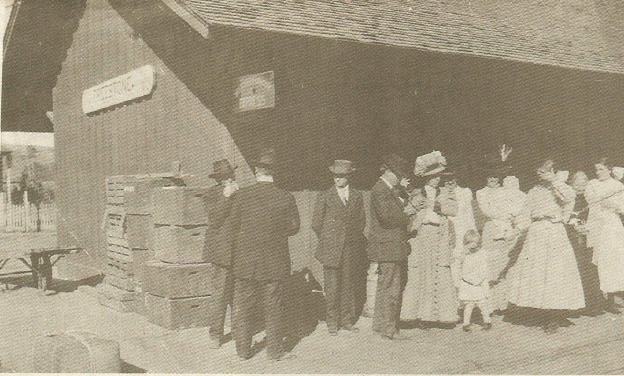Freestone
California historians note that General Vallejo was directed by the government of Mexico to extend
Mexico’s frontier in Sonoma County north toward the Russian settlement at Ft Ross in the mid-1800s.
Vallejo sent James McIntosh, James Dawson, and James Black to settle land near Freestone and they
became the first white settlers in this area. The town of Freestone was named in 1853 after a quarry of
sandstone in the locality. By 1872, Freestone had become a terminus for the North Pacific Railroad and
a trade center for the area. The photo on the next page shows the North Pacific Coast Railroad’s
Freestone Station as it looked in the 1900s. A map showing the located of Freestone is also on page 4.
The lumber industry eventually dwindled and the railroad was abandoned. This tiny town still has the
original 1887 school house and the post office operates in what was originally the town’s general store.
Today Freestone is known mainly for two businesses. The Wild Flour Bakery at the intersection of Bohemian
Highway and Highway 12 bakes breads in a wood-fired brick oven that are among the best in
Northern California. The nearby Osmosis is a world-renowned healing sanctuary in a Japanese-style
setting on five acres. The spa is famous for their cedar enzyme bath from Japan.
Times are changing in this sleepy, historic town as winegrowers and wineries look to profit from the
ideal growing conditions for Pinot Noir nearby. The most ambitious wine project to date is being conducted
by the J. Phelps Vineyards family (jpvfreestone.com).


In 1998, the Phelps family (known for their Napa Valley meritage, Insignia) purchased 55 acres in
Freestone and planted 40 acres to Pinot Noir and 19 acres to Chardonnay at the end of Freestone Flat
Road. The Freestone Flat Vineyard was then joined by an additional purchase nearby of the Quail Hill
Ranch where additional Pinot Noir is soon to be planted. This vineyard is on a south-facing hillside
above the fog line 8 miles in from the Pacific Ocean. Eventually, plantings will total 90-100 acres. The
project is a joint partnership between viticulturists Greg Cannon and Phillipe Pessereau, Bill Phelps,
Tom Shelton (CEO of Phelps), and winemaker Craig Williams (formerly Williams Selyem). A 40,000
square foot winery in the center of Freestone Flat Vineyard is nearing completion. It is bermed into
the hillside and employs gravity-flow via its three level construction. No tastings or tours will be done
at the winery due to environmental concerns, but a tasting room is being constructed at the corner of
Boehmian Highway and Highway 12 in the old Pastorale Building.
The entire project has been fraught with difficulties since the beginning. They principals have spent at
least $25 million dollars to date, including a reported $1 million to obtain the necessary permits and
pacify local residents. Gophers have been a major challenge and were eating 40% of the new plantings
until seven gopher-trappers were hired to eradicate the gophers. Ripening grapes properly in
this chilly climate has been a challenge and yields can be ridiculously low due to poor berry set in the
cool days of the spring growing season. It is not unusual to have 45 degree temperature swings in a
single day here!
It is unclear what the final label name will be (Phelps owns the rights to the name Freestone). The first
vintage of Pinot Noir produced from Sonoma Coast grapes has been released as the 2004 fogdog Pinot
Noir. Fog dog is a bright or clear spot that appears in a breaking fog. This wine contains grapes from
three estate-grown vineyards: 70% Freestone, 26% Quarter Moon, and 4% Ferguson. It was aged in
40% new and 60% 1 to 3 year-old oak barrels. (Don’t confuse the name with Radog, a Central Coast
Pinot Noir). The wine is distributed to fine wine retail stores.
2004 fogdog Sonoma Coast Pinot Noir
13.8% alc., $30.
·
The wine
takes a while to open as the natural carbon dioxide present dissipates.
The nose is unusual featuring pepper, wet leaves, dark chocolate and
even exotic wood aromas. Red fruits, particularly cherries, are noteworthy.
The finish is short and clean. The big acid spine screams for food.